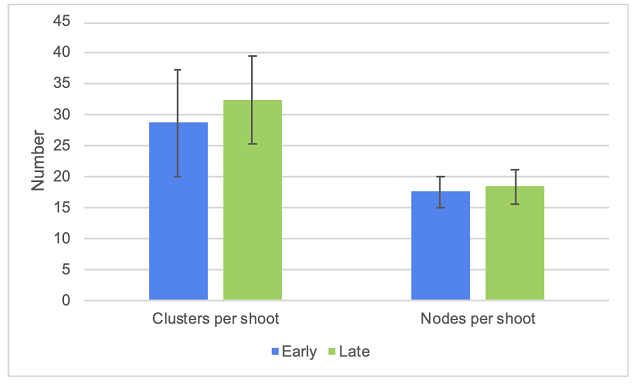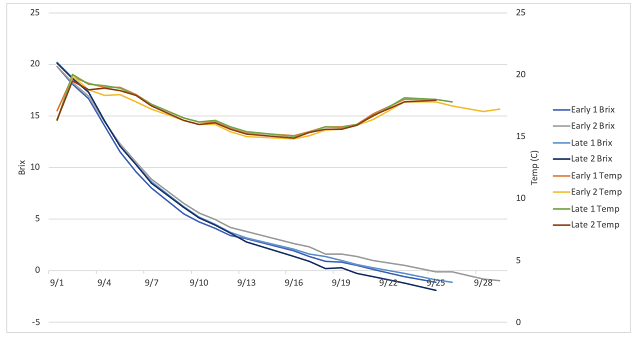Effect of the timing of defoliation through leaf pulling on Chardonnay
Silvia Liggieri and Corry Craighill
Sunset Hills Vineyards
Summary
Growing conditions in Virginia often lead to high vigor canopies and leaf pulling is often employed to manage disease pressure. Leaf pulling in chardonnay has been shown to decrease disease pressure. This study examined the impact of the timing of leaf pulling on the chemical and sensory properties of Chardonnay. Three leaves per shoot were pulled at full bloom or after fruitset. There were no significant differences in fruit metrics. Juice and wine metrics were nearly identical between treatments. There were no significant differences in sensory characteristics.
Introduction
Growing conditions in Virginia often lead to high vigor canopies. These high vigor, high density canopies can cause a number of problems in the vineyard and the winery. High vigor canopies often contain inner leaves that do not receive adequate sunlight such that they become carbohydrate sinks rather than sources1. Densely shaded canopies have higher incidence of disease due to poor air flow and poor spray penetration. Shading of developing buds for the following year can lead to fewer inflorescences per shoot2, smaller clusters and reduced berry set1. Shaded fruit can also have higher potassium, pH and TA as well as reduced phenolic compounds, pigments, varietal flavor, and overall sugar accumulation1. Shading can also lead to higher levels of compounds that produce vegetal flavors such as methoxypyrazine and C6 alcohols1,2. By contrast, open canopies in general lead to higher sugar, color, and positive aroma compounds such as nor-isoprenoids (which lead to varietal character in aromatic white wines) and terpenes (which contribute floral, Muscat-like aromas to wine)2.
In a study of defoliation by leaf pulling in Chardonnay in Virginia, Silvia Liggieri3 found consistently lower disease severity with leaf pulling of 3 and 6 leaves near the fruit zone, fewer berries per cluster, and higher free norisoprenoids, though total norisoprenoids decreased with leaf pulling. In this study, leaves were pulled from Chardonnay at either full bloom/25% fruit set (early) or post fruit set (late) to determine if early leaf pull would allow berries to acclimate to greater sunlight exposure while providing a better microclimate against disease.
Methods
The Chardonnay block of the SHV vineyard was divided in half with rows 23-38 serving as the early leaf pulling treatment and rows 38-45 serving as the late leaf pulling treatment. For each, three leaves were pulled per shoot; under, lateral and above the cluster. Leaves were pulled at full bloom (25% fruit set) and post fruit set.
Fruit was harvested on the same day (8/26), refrigerated overnight, then whole cluster pressed with the addition of 10ml/ton Cinn Free to the press pan. The press fraction was diverted at 1.7 Bar. Juice was cold settled overnight at 7°C, then racked to a holding tank. Turbidity was measured and corrected to NTU = 140 for each lot. Juice was inoculated in tank with 15 g/hL D47 then transferred to barrel for fermentation. There were two barrels per treatment, with two sets of identical cooperage and age. A 25g/hL addition of Fermaid O was made to all barrels on 9/3, after the end of lag phase. Fermentation was monitored daily for Brix and temperature. All barrels completed malolactic fermentation prior to treatment with 40 ppm SO2 on Jan 3 followed by another addition of 35 ppm SO2 on Jan 21.
Sensory analysis was completed by a panel of 29 wine producers. Wines were presented blind in randomly numbered glasses. Tasters were presented with three wines, two of one type and one of another, and asked to identify which wine was different (a triangle test). There were three tasting groups with the unique wine in the triangle test balanced between groups. Tasters were then asked to score each wine on a scale of 0 to 10 for aromatic intensity, freshness, fruit intensity, and Chardonnay varietal character. They were also given open ended questions to describe the wines. Results for the triangle test were analyzed using a one-tailed Z test. Descriptive scores were analyzed using repeated measures ANOVA.
Results
There was no significant difference in clusters per shoot nor nodes per shoot based on leaf pulling regime (Figure 1). There were no large differences in fruit metrics at harvest between lots (Table 1), though there were higher cluster weights in the late pull. This lot also had higher yield (data not shown)(Silvia Liggieri, personal communication). Logistically, the timing for early leaf pulling was much more restricted, with only a 5-day window in which to do the work while the post fruit set regime allowed for a wider range of timing.
Juice chemistry between the two regimes was very similar (Table 2). TA was higher in early leaf pull than late leaf pull. Additional exposure time did not diminish acidity in this trial. Fermentation kinetics were very similar for all four barrels (Figure 2) and acid chemistry was very similar for all four finished barrels (Table 3), indicating leaf pull did not affect acidity. Potassium was also not affected by leaf pulling.
In a triangle test of wines made from early vs. late leaf pull, 13 out of 29 respondents were able to distinguish which wine was different, indicating the wines were not significantly different (Z=1.116, p= 0.013). There were also no significant differences in scores for aromatic intensity, freshness, fruit intensity, or Chardonnay varietal character.
Figure 1: Effect of early vs. late leaf pulling on vineyard metrics (in-house data)

Table 1: Fruit metrics for two leaf pulling regimes (in-house data)

Table 2: Juice metrics for two leaf pulling regimes (in-house data)

Figure 1: Fermentation kinetics for two leaf pulling regimes (in-house data)

Table 3: Wine chemistry for two leaf pulling regimes (ICV Labs January 2020)

Table 4: Descriptive scores for wines from two leaf pulling regimes (WRE)

References
(1) Wolf, T. K. Wine Grape Production Guide for Eastern North America; Plant and Life Sciences Publishing: Ithaca, New York, 2008.
(2) Vance, A.; Reeve, A.; Skinkis, P. The Role of Canopy Management in Vine Balance. OSU Extension Catalogue 2013.
(3) Liggieri, S. Fruit Exposure Impact on Grape Aroma Development; Omni Hotel, Charlottesville, Virginia, 2019.
